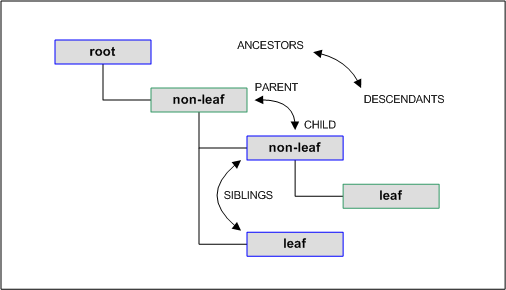Abstract Message Structure
The runtime message structure is composed of a hierarchical system of nodes. These nodes are characterized by terms indicating their relationships with each other:
Parent, Child, and Sibling Nodes
Any subnode of a given node is called a child node, and the given node, in turn, is the child’s parent. Sibling nodes are nodes on the same hierarchical level under the same parent node. Nodes higher than a given node in the same lineage are ancestors and those below it are descendants.
Figure 1 Encoder Node Relationships

Root Nodes
The root node is the highest node in the tree structure, and has no parent. This node is a global element and represents the entire message. It may have one or more child nodes, but can never have sibling nodes or be repeating. The name of the root node can be edited.
Non-leaf Nodes
Non-leaf nodes, which can have children, provide the framework through which this data is accessed and organized. They are of complex types.
There are two major types of non-leaf nodes (aside from a root node, which is a special case):
-
Sequence group nodes, which provide organizational grouping for purposes such as repetition. In XSD, they are of complexType of a sequence of elements.
-
Choice group nodes, which represent sets of alternatives— only one of which is valid at any given time for an instance of that node. For example, a choice node named order might have two children, respectively named domestic and overseas. For each order instance, only one of these children will be present. In XSD, they are of complexType of a choice group of elements.
Leaf Nodes
Leaf nodes have no children, and normally carry the actual data from the message. They are of simple types such as string.
The basic node types are fixedLength and delimited. See Encoding Properties for information about other node types.
-
With fixedLength data, the length of the unit of data is always the same. The position of the data within the message string is described by byte offset and length.
-
With delimited data, the length of the unit of data is variable. Information is separated by a pre-determined system of delimiters defined within the properties of the Encoder (see Specifying Delimiters).
- © 2010, Oracle Corporation and/or its affiliates
